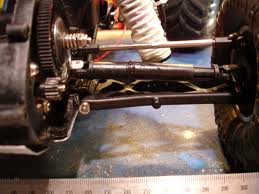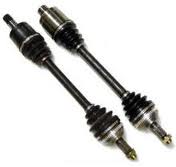Drive Shafts
Drive Shafts, driveshafts, driving shafts, propeller shafts (prop shaft), or Cardan Shafts is a mechanical component for transmitting torque and rotation, usually used to connect other components of a drive train that cannot be connected directly because of distance or the need to allow for relative movement between them.
Drive shafts are carriers of torque: they are subject to torsion and shear stress, equivalent to the difference between the input torque and the load. They must therefore be strong enough to bear the stress, whilst avoiding too much additional weight as that would in turn increase their inertia. To allow for variations in the alignment and distance between the driving and driven components, drive shafts frequently incorporate one or more universal joints, jaw couplings, or rag joints, and sometimes a splined joint or prismatic joint.
History
The term drive shaft first appeared during the mid 19th century. In Storer's 1861 patent reissue for a planing and matching machine, the term is used to refer to the belt-driven shaft by which the machine is driven.The term is not used in his original patent.Another early use of the term occurs in the 1861 patent reissue for the Watkins and Bryson horse-drawn mowing machine.Here, the term refers to the shaft transmitting power from the machine's wheels to the gear train that works the cutting mechanism.
In the 1890s, the term began to be used in a manner closer to the modern sense. In 1891, for example, Battles referred to the shaft between the transmission and driving trucks of his Climax locomotive as the drive shaft,and Stillman referred to the shaft linking the crankshaft to the rear axle of his shaft-driven bicycle as a drive shaft.In 1899, Bukey used the term to describe the shaft transmitting power from the wheel to the driven machinery by a universal joint in his Horse-Power.In the same year, Clark described his Marine Velocipede using the term to refer to the gear-driven shaft transmitting power through a universal joint to the propeller shaft. Crompton used the term to refer to the shaft between the transmission of his steam-powered Motor Vehicle of 1903 and the driven axle.
Motorcycle drive shafts
Drive shafts have been used on motorcycles almost as long as there have been motorcycles. As an alternative to chain and belt drives, drive shafts offer relatively maintenance-free operation and long life. A disadvantage of shaft drive on a motorcycle is that gearing or a Hobson's joint or similar is needed to turn the power 90° from the shaft to the rear wheel, losing some power in the process. On the other hand, it is easier to protect the shaft linkages and drive gears from dust, sand and mud.
The best known motorcycle manufacturer to use shaft drive for a long time—since 1923—is BMW. Among contemporary manufacturers, Moto Guzzi is also well known for its shaft drive motorcycles. The British company, Triumph and all four Japanese brands, Honda, Suzuki, Kawasaki and Yamaha, have produced shaft drive motorcycles. All geared models of the Vespa scooter produced to date have been shaft-driven. The automatic models, however, use a belt. Motorcycle engines positioned such that the crankshaft is longitudinal and parallel to the frame are often used for shaft driven motorcycles. This requires only one 90° turn in power transmission, rather than two. Bikes from Moto Guzzi and BMW, plus the Triumph Rocket III and Honda ST series all use this engine layout.
Motorcycles with shaft drive are subject to shaft effect where the chassis climbs when power is applied. This is counteracted with systems such as BMW's Paralever, Moto Guzzi's CARC and Kawasaki's Tetra Lever.
Marine drive shafts
On a power-driven ship, the drive shaft, or propeller shaft, usually connects the transmission inside the vessel directly to the propeller, passing through a stuffing box or other seal at the point it exits the hull. There is also a thrust block, a bearing to resist the axial force of the propeller. As the rotating propeller pushes the vessel forward, any length of drive shaft between propeller and thrust block is subject to compression, and when going astern to tension. Except for the very smallest of boats, this force isn't taken on the gearbox or engine directly.
Cardan shafts are also often used in marine applications between the transmission and either a propeller gearbox or waterjet.
Locomotive drive shafts
The Shay, Climax and Heisler locomotives, all introduced in the late 19th century, used quill drives to couple power from a centrally mounted multi-cylinder engine to each of the trucks supporting the engine. On each of these geared steam locomotives, one end of each drive shaft was coupled to the driven truck through a universal joint while the other end was powered by the crankshaft, transmission or another truck through a second universal joint. A quill drive also has the ability to slide length ways, effectively varying its length. This is required to allow the bogies to rotate when passing a curve.
Cardan shafts are used in some diesel locomotives and some electric locomotives . They are also widely used in diesel multiple units.

